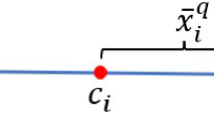Abstract
Moth flame optimization (MFO) is a recent nature-inspired algorithm, motivated from the transverse orientation of moths in nature. The transverse orientation is a special kind of navigation method, which demonstrates the movement of moths toward moon in a straight path. This algorithm has been successfully applied on various optimization problems. But, MFO suffers from the problem of poor exploration. So, in order to enhance the performance of MFO, some modifications are proposed. A Cauchy distribution function is added to enhance the exploration capability, influence of best flame has been added to improve the exploitation and adaptive step size and division of iterations is followed to maintain a balance between the exploration and exploitation. The proposed algorithm has been named as enhanced moth flame optimization (E-MFO) and to validate the applicability of E-MFO, and it has been applied to twenty benchmark functions. Also, comprehensive comparison of E-MFO with other meta-heuristic algorithms like bat algorithm, bat flower pollination, differential evolution, firefly algorithm, genetic algorithm, particle swarm optimization and flower pollination algorithm has been done. Further, the effect of population and dimension size on the performance of MFO and E-MFO has been discussed. The experimental analysis shows the superior performance of E-MFO over other algorithms in terms of convergence rate and solution quality. Also, statistical testing of E-MFO has been done to prove its significance.









Similar content being viewed by others
References
Gutjahr WJ (2009) Convergence analysis of metaheuristics. In: Matheuristics. Springer, Boston, pp 159–187
Bonabeau E, Dorigo M, Theraulaz G (1999) Swarm intelligence: from natural to artificial systems (No. 1). Oxford University Press, New York
Bansal JC, Sharma H, Jadon SS, Clerc M (2014) Spider monkey optimization algorithm for numerical optimization. Memet Comput 6(1):31–47
Eberhart R, Kennedy J (1995) A new optimizer using particle swarm theory. In: Proceedings of the sixth international symposium on micro machine and human science, 1995, MHS’95. IEEE, pp 39–43
Dorigo M, Birattari M, Stutzle T (2006) Ant colony optimization. IEEE Comput Intell Mag 1(4):28–39
Karaboga D, Basturk B (2007) Artificial bee colony (ABC) optimization algorithm for solving constrained optimization problems. In: International fuzzy systems association world congress. Springer, Berlin, pp 789–798
Yang XS, Deb S (2009) Cuckoo search via Lévy flights. In: World congress on Nature & Biologically Inspired Computing, 2009. NaBIC 2009. IEEE, pp 210–214
Yang XS (2010) A new metaheuristic bat-inspired algorithm. In: Gonzalez JR et al (eds) Nature inspired cooperative strategies for optimization (NICSO 2010). Springer, Berlin, pp 65–74
Yang XS (2010) Firefly algorithm, stochastic test functions and design optimization. Int J Bio-Inspired Comput 2(2):78–84
Mirjalili S, Mirjalili SM, Lewis A (2014) Grey wolf optimizer. Adv Eng Softw 69:46–61
Mirjalili S, Lewis A (2016) The whale optimization algorithm. Adv Eng Softw 95:51–67
Holland JH (1992) Genetic algorithms. Sci Am 267(1):66–72
Storn R, Price K (1995) Differential evolution—a simple and efficient adaptive scheme for global optimization over continuous spaces, vol 3. ICSI, Berkeley
Koza JR (1992) Genetic programming: on the programming of computers by means of natural selection, vol 1. MIT Press, Cambridge
Simon D (2008) Biogeography-based optimization. IEEE Trans Evol Comput 12(6):702–713
Mirjalili S (2015) The ant lion optimizer. Adv Eng Softw 83:80–98
Rechenberg I (1978) Evolutions strategien. In: Schneider B, Ranft U (eds) Simulationsm ethoden in der Medizin und Biologie. Springer, Berlin, pp 83–114
Mirjalili S (2015) Moth-flame optimization algorithm: a novel nature-inspired heuristic paradigm. Knowl-Based Syst 89:228–249
Muangkote N, Sunat K, Chiewchanwattana S (2016) Multilevel thresholding for satellite image segmentation with moth-flame based optimization. In: 2016 13th international joint conference on computer science and software engineering (JCSSE). IEEE, pp 1–6
Bentouati Bachir, Chaib Lakhdar, Chettih Saliha (2016) Optimal power flow using the moth flam optimizer: a case study of the algerian power system. Indones J Electr Eng Comput Sci 1(3):431–445
Yamany W, Fawzy M, Tharwat A, Hassanien AE (2015) Moth-flame optimization for training multi-layer perceptrons. In: 2015 11th international computer engineering conference (ICENCO). IEEE, pp 267–272
Wolpert DH, Macready WG (1997) No free lunch theorems for optimization. IEEE Trans Evol Comput 1(1):67–82
Li Z, Zhou Y, Zhang S, Song J (2016) Lévy-flight moth-flame algorithm for function optimization and engineering design problems. Math Probl Eng. https://doi.org/10.1155/2016/1423930
Soliman GM, Khorshid MM, Abou-El-Enien TH (2016) Modified moth-flame optimization algorithms for terrorism prediction. Int J Appl Innov Eng Manag 5(7):47–58
Allam Dalia, Yousri DA, Eteiba MB (2016) Parameters extraction of the three diode model for the multi-crystalline solar cell/module using moth-flame optimization algorithm. Energy Convers Manag 123:535–548
Hassanien Aboul Ella, Gaber Tarek, Mokhtar Usama, Hefny Hesham (2017) An improved moth flame optimization algorithm based on rough sets for tomato diseases detection. Comput Electron Agric 136:86–96
Ceylan O (2016) Harmonic elimination of multilevel inverters by moth-flame optimization algorithm. In: International symposium on industrial electronics (INDEL). IEEE, pp 1–5
Garg P, Gupta A (2016) Optimized open shortest path first algorithm based on moth flame optimization. Indian J Sci Technol. https://doi.org/10.17485/ijst/2016/v9i48/104255
Parmar SA, Pandya MH, Bhoye M, Trivedi IN, Jangir P, Ladumor D (2016) Optimal active and reactive power dispatch problem solution using moth-flame optimizer algorithm. In: 2016 international conference on energy efficient technologies for sustainability (ICEETS). IEEE, pp 491–496
Yang XS (2012) Flower pollination algorithm for global optimization. In: International conference on unconventional computing and natural computation. Springer, Berlin, pp 240–249
Salgotra R, Singh U (2016) A novel bat flower pollination algorithm for synthesis of linear antenna arrays. Neural Comput Appl. https://doi.org/10.1007/s00521-016-2833-3
Derrac J, García S, Molina D, Herrera F (2011) A practical tutorial on the use of nonparametric statistical tests as a methodology for comparing Evolutionary and swarm intelligence algorithms. Swarm Evolut Comput 1(1):3–18
Author information
Authors and Affiliations
Corresponding author
Ethics declarations
Conflict of interest
The authors declare that there is no conflict of interests regarding the publication of this paper.
Rights and permissions
About this article
Cite this article
Kaur, K., Singh, U. & Salgotra, R. An enhanced moth flame optimization. Neural Comput & Applic 32, 2315–2349 (2020). https://doi.org/10.1007/s00521-018-3821-6
Received:
Accepted:
Published:
Issue Date:
DOI: https://doi.org/10.1007/s00521-018-3821-6




